
Siena
Cathedral - Table of Contents ..................................
Architecture
Around the World
Interior - Siena
Cathedral/Duomo di Siena
2020 photosOn this page, below:
Nave and Aisles
Chancel
"Paulus V" stained glass window
"Last Supper" stained glass window
Pulpit
Marble floor - Sibyls
Marble floor - Battle scene
Transepts: "St. John the Baptist" / Chapel of the Madonna del Voto
Piccolomini Altar
Rear (main entrance)
Excerpts from Sacred Destinations: Sienna Duomo
Nave and Aisles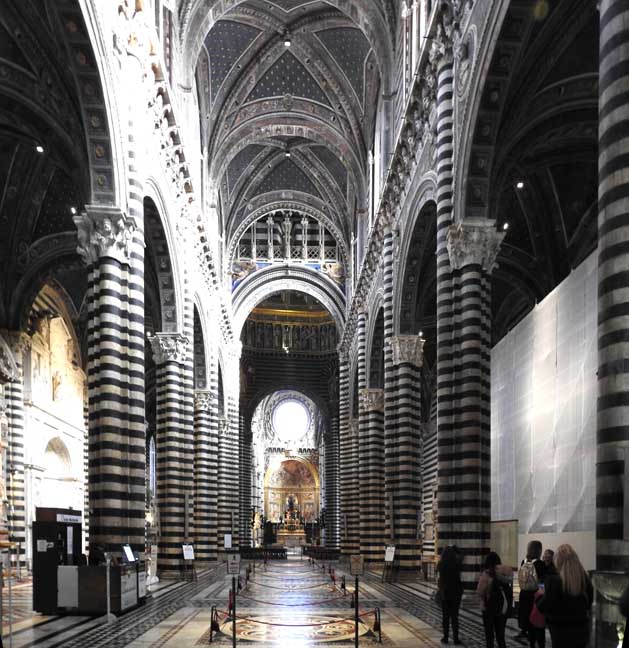 Nave ... The exterior and interior are constructed of white and greenish-black marble in alternating stripes, with the addition of red marble on the façade. ... Black and white (the colors of the civic coat of arms of Siena) engaged columns ... Aisle at right is undergoing restoration 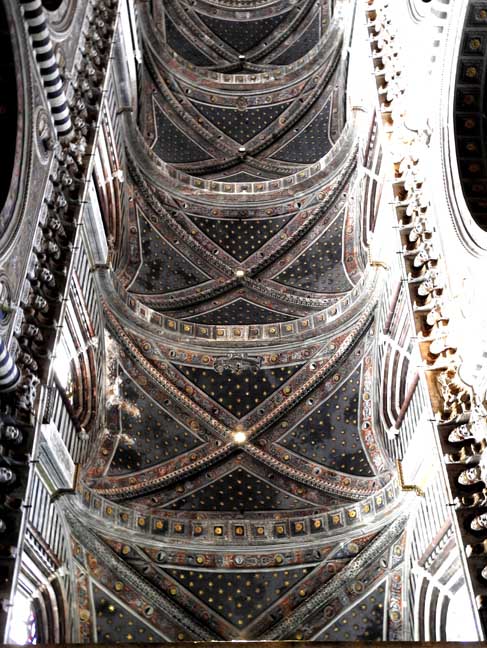 Nave ... The vaulted roof is decorated in blue with golden stars 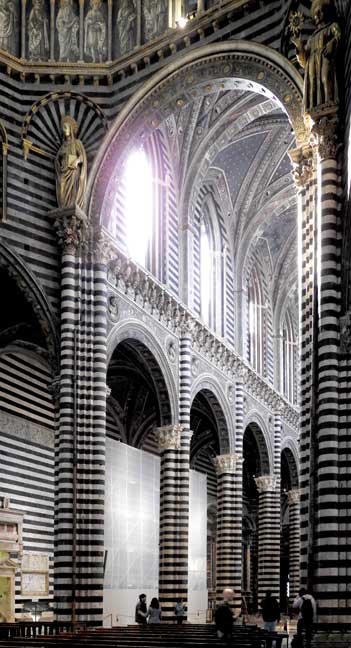 Nave ... "The cornice that
runs the length of the nave is
decorated with busts of popes made in the workshop of Giovanni di
Stefano beginning in 1495. Only four or five terracotta
molds were used
to make the busts, so many of them are identical. Below are 36 busts of
Roman and Byzantine emperors from Constantine
to Theodosius. " - Sacred
Destinations: Siena Duomo (online March 2020)
.... Aisle covered for restoration
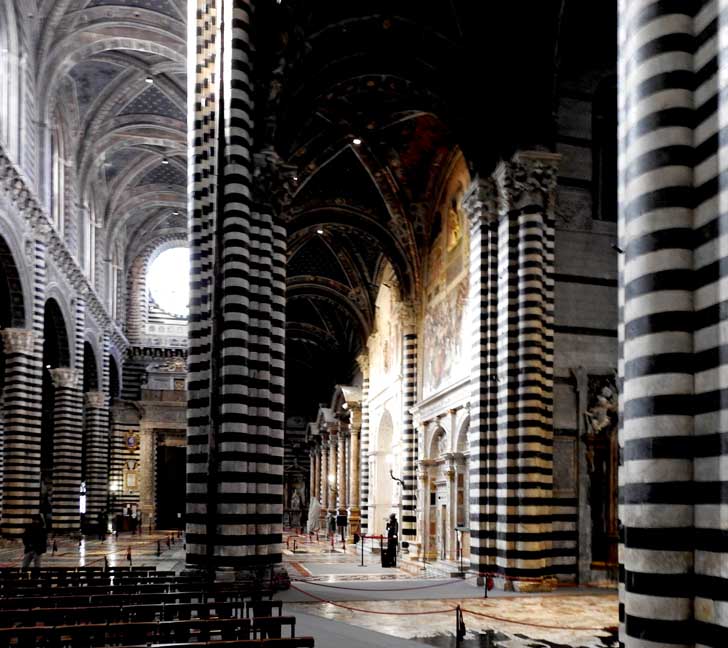 Nave ... Nave and aisle |
Chancel Chancel The hexagonal dome is topped with Bernini's gilded lantern, like a golden sun. Coffers were painted in blue with golden stars in the late 15th century. 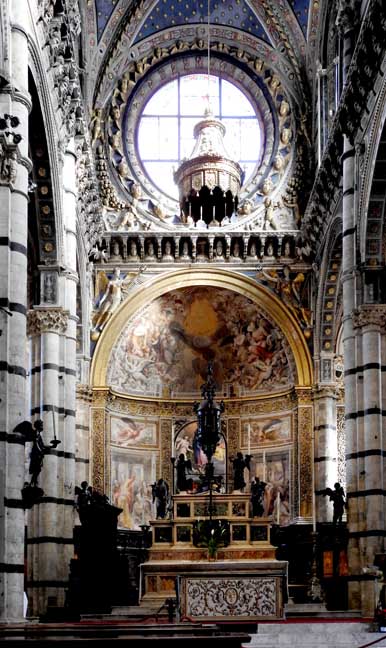 Chancel Note round stained glass window, "The Life of Mary," at top, detailed below: 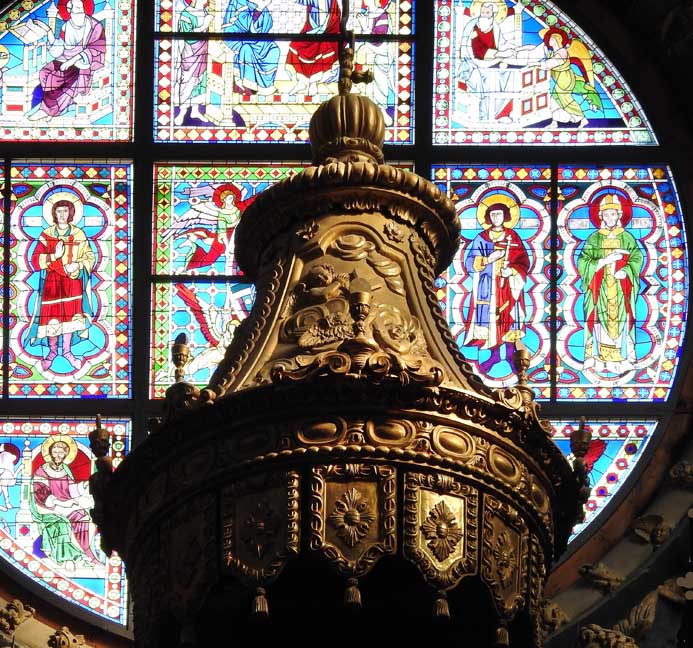 Chancel ... "The Life of Mary" ... Six details below: 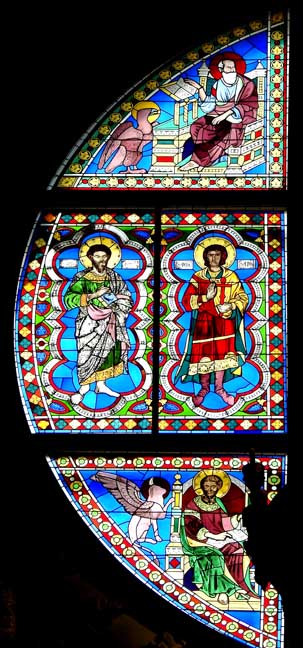 "The Life of Mary" - Detail #1 Top: John the Evangelist with eagle ... Bottom: Luke the Evangelist with winged ox  "The Life of Mary" - Detail #2 Top left: Coronation ... Bottom left: Dormition ... Top right: Matthew the Evangelist with angel ... Bottom right: Mark the Evangelist with winged lion  "The Life of Mary" - Detail #3 Coronation  "The Life of Mary" - Detail #4 Queen of Heaven ... Note mandorla 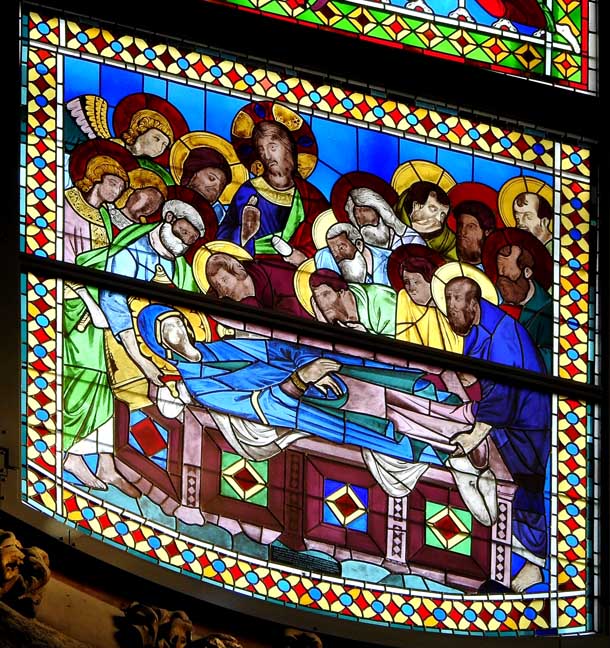 "The Life of Mary" - Detail #5 Dormition  "The Life of Mary" - Detail #6 Top: Matthew the Evangelist with angel |
"Paulus V" stained glass window "Paulus V" stained glass window ... Two details below:  "Paulus V" stained glass window Eagles and dragons are the heraldic symbols of the Siena Borghese family ... Camillo Borghese was pope from 1605 to 1621)  "Paulus V" stained glass window Papal crown: tiara ... Two crossed keys of St. Peter |
|
Created by Pastorino de Pastorini, the stained-glass round window high in the choir area of this medieval church was made in 1288 and depicts the Last Supper of Christ from the New Testament. The work is considered to be one of the earliest remaining examples of Italian stained glass. 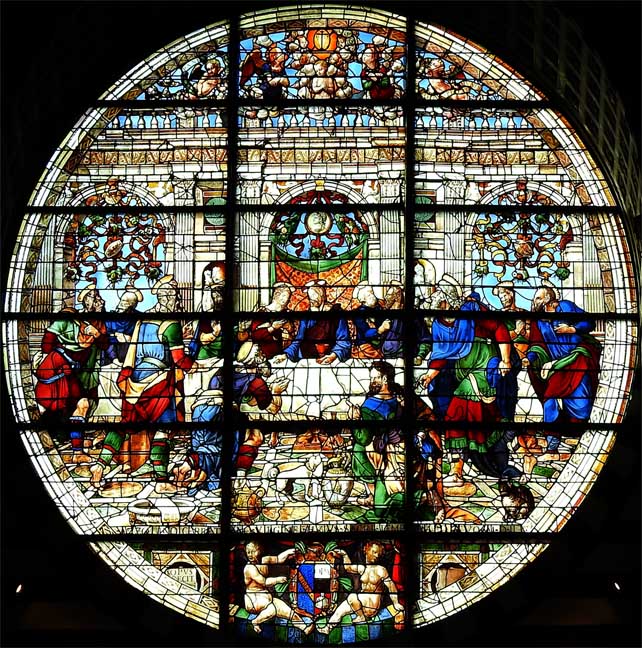 "Last Supper" ... Five details below: 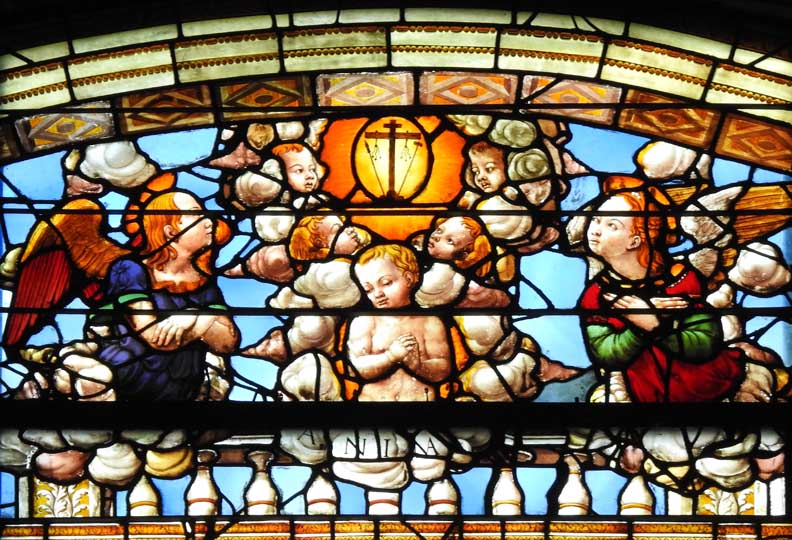 "Last Supper" - Detail #1 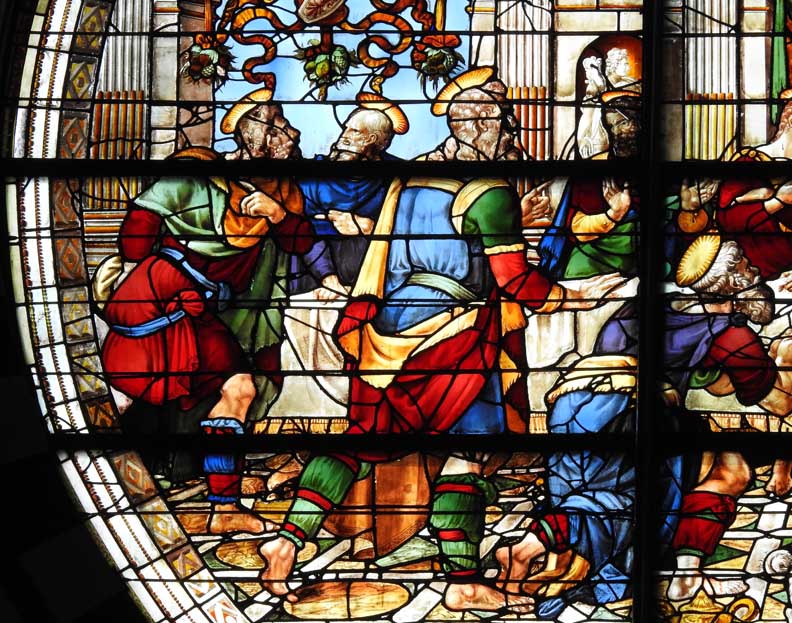 "Last Supper" - Detail #2  "Last Supper" - Detail #3 Judas 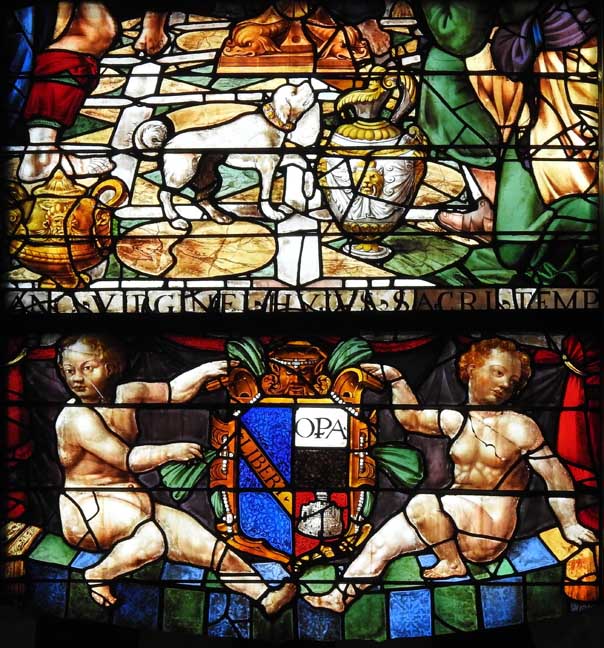 "Last Supper" - Detail #4 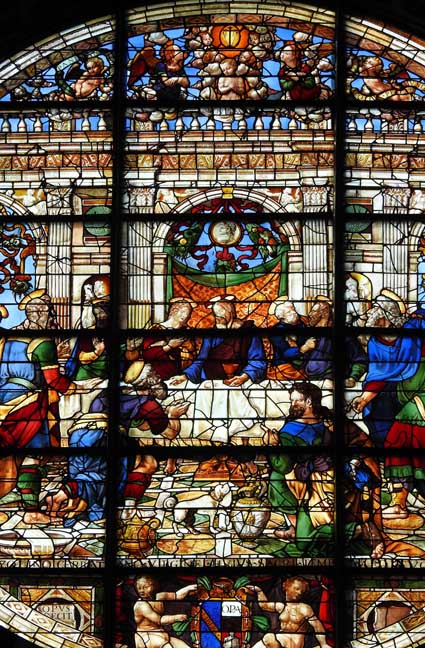 "Last Supper" - Detail #5 |
Pulpit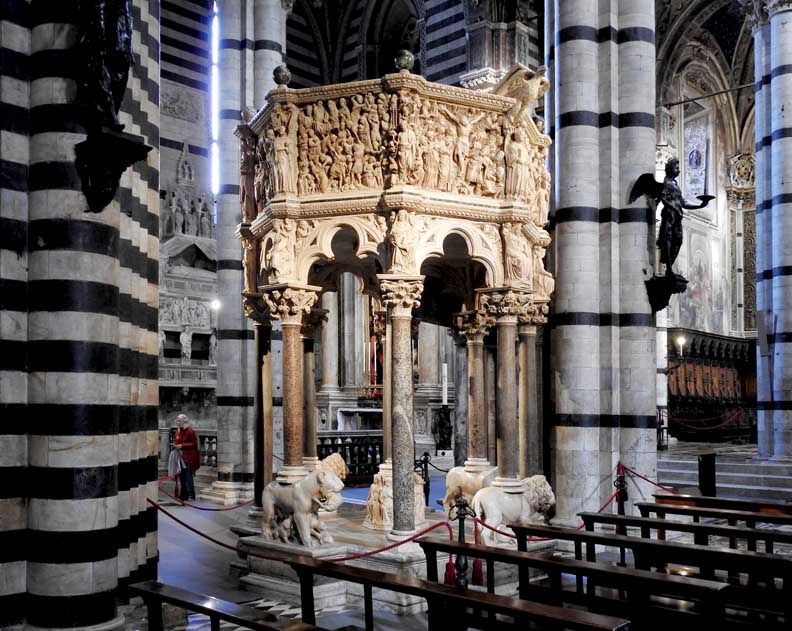 Pulpit ... "For the construction of the pulpit,
a contract was drawn up in Pisa on September 29, 1265 between the
artist Nicola Pisano and the Cistercian Fra Melano, who was
the Master of the Cathedral works of Siena. Nicola had earned fame from
his work on the pulpit in the Baptistery in Pisa, which he had finished
in 1260. This contract stipulated ... that there were to be seven
panels instead of five such as in Pisa and it also stated that Pisano
needed to use the Sienese Carrara marble." - Wikipedia
(online March 2020) ... "The seven
marble panels depict the life of Christ in crowded scenes full of
movement and life." - Sacred
Destinations (online March 2020)
...
Ten details below: Pulpit - Detail #1 “The Visitation and the
Nativity: The Virgin Annuciate introduces
the Visitation relief. In the first corner, on your left hand
side there is the image of the Madonna
with the announcing angel [Annunciation].
To the right of that there are two women, who look like Roman
matrons who clasp hands 'enacting the visitation.' Below them are two
midwives washing the child, which may be the work of Arnolfo di
Cambi. In the center of the relief, Mary lounges like a
'classical goddess or empress.' To the right of her the panel depicts
the visiting shepherds
[Nativity], who are dressed in Roman tunics, while
their sheep,
clustered around the Virgin’s bed, have surely strayed in from some
Virgilian Pastoral, or from Jason's quest. At the Upper right, above
the
shepherds, intrudes the large head of a Roman Emperor, his
beard and hair well-drilled in true lapidary fashion. Also on this
panel one can see the French Gothic influence. Above the two Roman
matrons emerges an image of an Gothic arch and 'the character of this
architecture, its relative elegance and thinness of proportions,
suggests transalpine influence." - Wikipedia
(online March 2020)
 Pulpit - Detail #2 "Journey
[Flight into Egypt] and Adoration of the
Magi:
Between the images of the Shepherds' visitation to Mary and the new
born Jesus to the next panel containing the journey and adoration of
the magi stands a carving of Isaiah, who was an 8th-century
prophet.
The panels reliefs begin with horsemen riding in from the left
with
other animals, such as camels and dogs carved into the panel as well.
Added with the flora sculpted above the magi, it can be seen
that
Nicola wanted to embrace naturalistic themes. The upper right hand
corner holds the scene with Jesus being adored by the Magi
while
sitting on his mother’s lap. The fold of the robes that each
character
wears and the S-shape pattern in the hair denotes Roman stylistic
influence." - Wikipedia
(online March 2020)
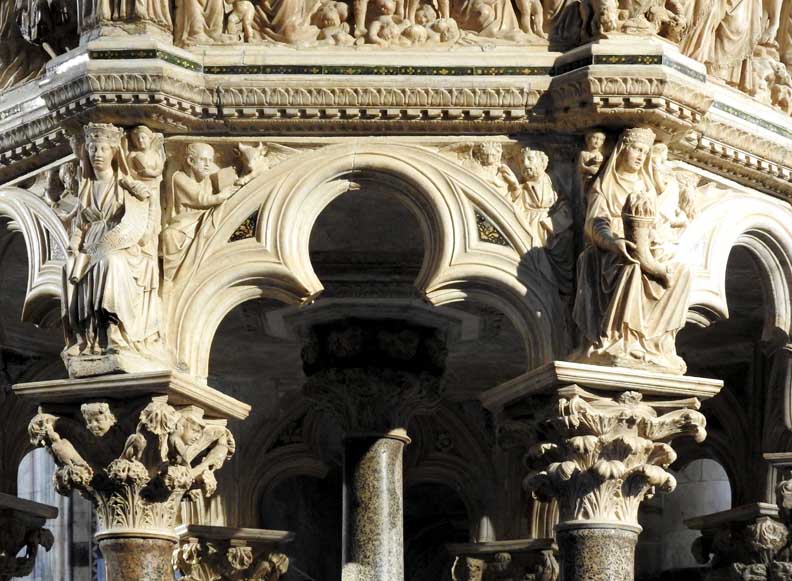 Pulpit - Detail #3 Trefoil arch ... Corinthian capitals 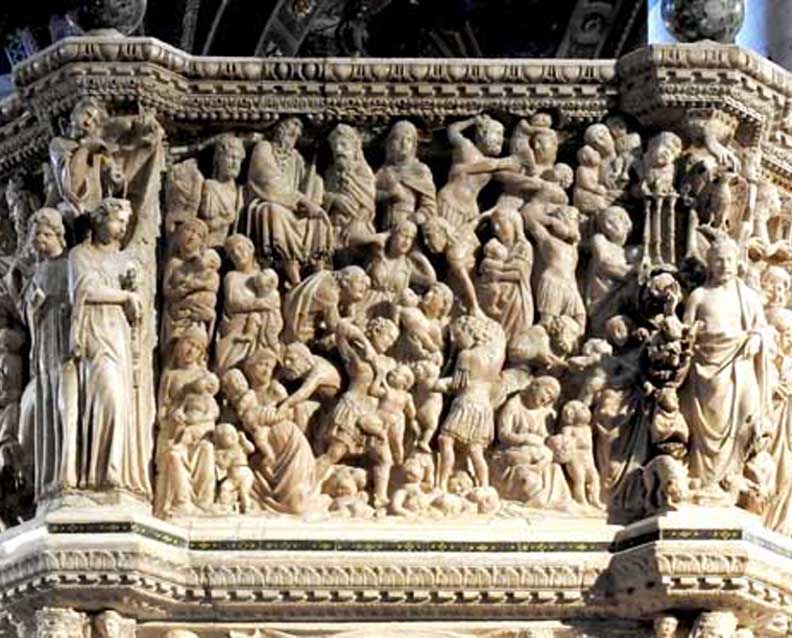 Pulpit - Detail #4 "Massacre of the Innocents:
Leading from the Flight into Egypt to the Fourth Panel of the Massacre
there is the image of three angels. This relief is the one that takes
central spot upon the pulpit. It is also the only panel that does not
contain Jesus or his family, in fact it is concerned with the absence
of Christ, because it depicts when King Herod decreed the mass
killing of the baby boys in Bethlehem to avoid the prophecy that the 'King of
Jews' [INRI] would take his throne. This panel is also a new
addition
to the tradition of pulpits. It cannot be found in Nicolas' previous
Pisa pulpit and it also differs from its predecessors by having 24 nude
children rather than the common 3 or 4. This panel is a good example of
Nicolas attention to emotion and movement. The struggle between the
families clutching their children and the Roman soldiers (wearing
traditional Roman uniform) is true classical form. With none of the
characters arranged stiffly but rather lunging, shirking and squirming
in the panel." - Wikipedia
(online March 2020)
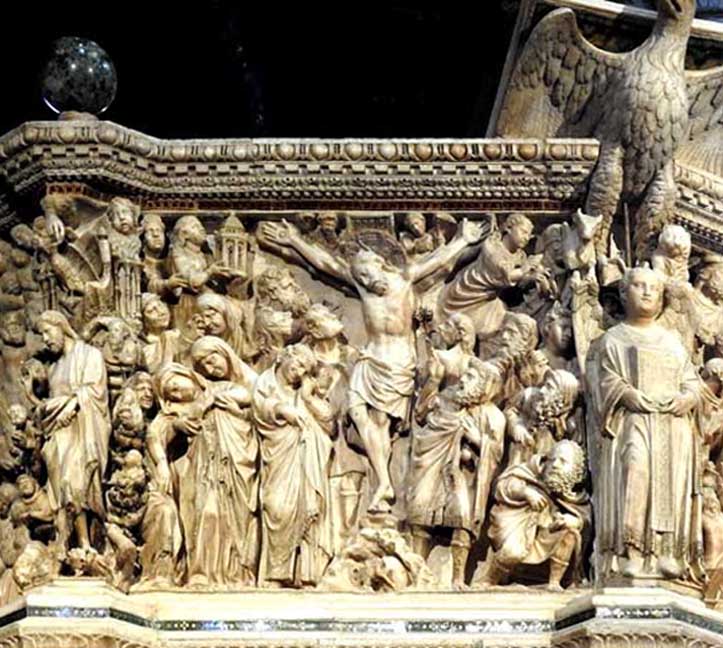 Pulpit - Detail #5 "Crucifixion:
This carving
introduces the next relief panel depicting the Crucifixion. In the
center on the panel Jesus hangs upon the cross traditionally
shown with his head falling to the side and modestly covered in a loin
cloth. A new addition that Nicola made to the crucified Savior is the
joining of Christ’s feet upon the cross with one nail. This had not
been seen before the 13th century. Surrounding Jesus is a scene of
onlookers and mourners. To the left of Christ stands the image of Mary
physically grieving. Her stance and emotion is another motif of the
13th century as it became common to depict the Virgin as swooning. This
panel is also a good example of Nicolas
understanding of depth with the foreground figures being the largest."
- Wikipedia
(online March 2020)
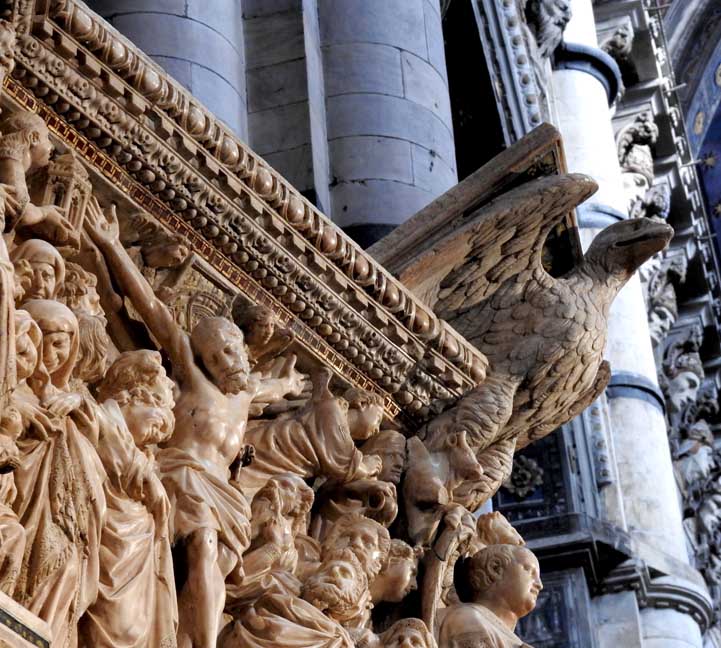 Pulpit - Detail #6 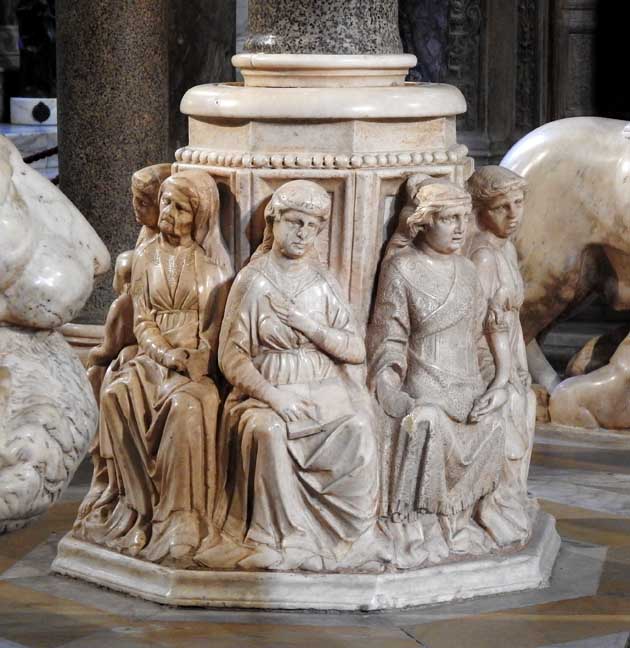 Pulpit - Detail #7 Base of the central column is populated by the personified liberal arts 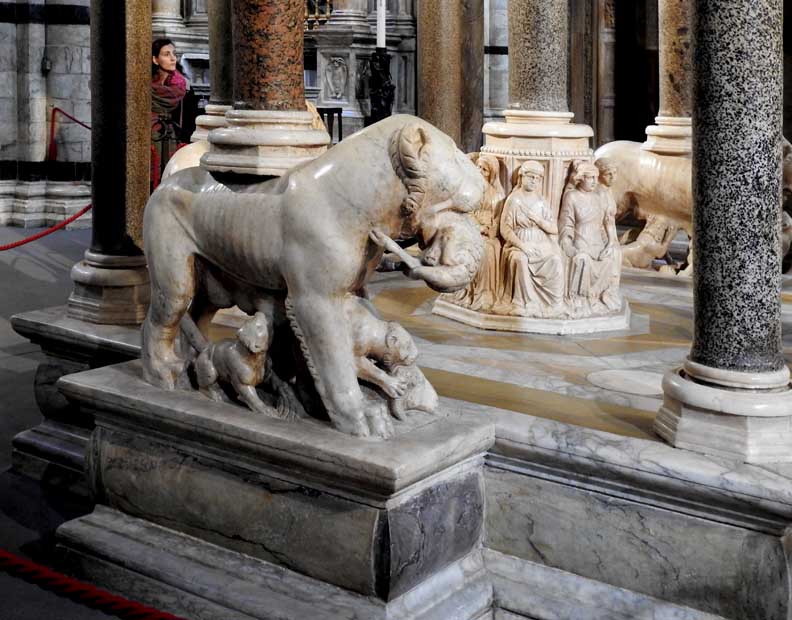 Pulpit - Detail #8 Four of the eight outer columns rest on lions 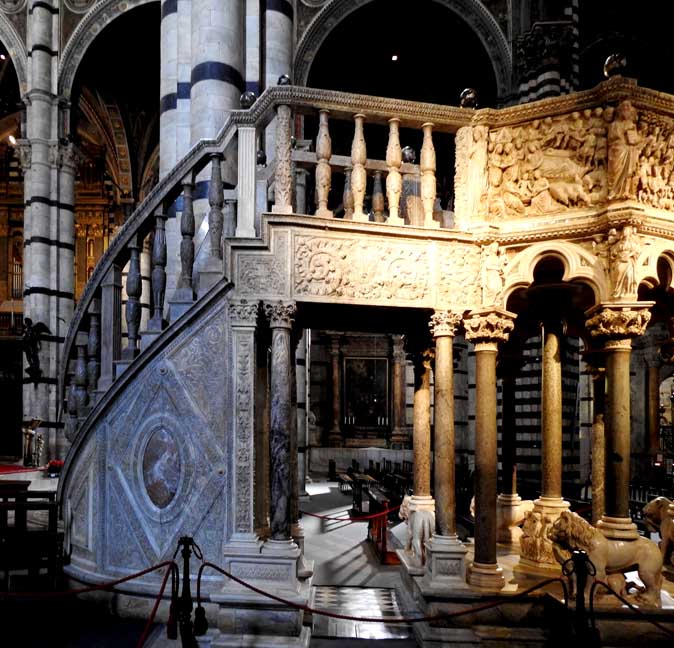 Pulpit - Detail #9 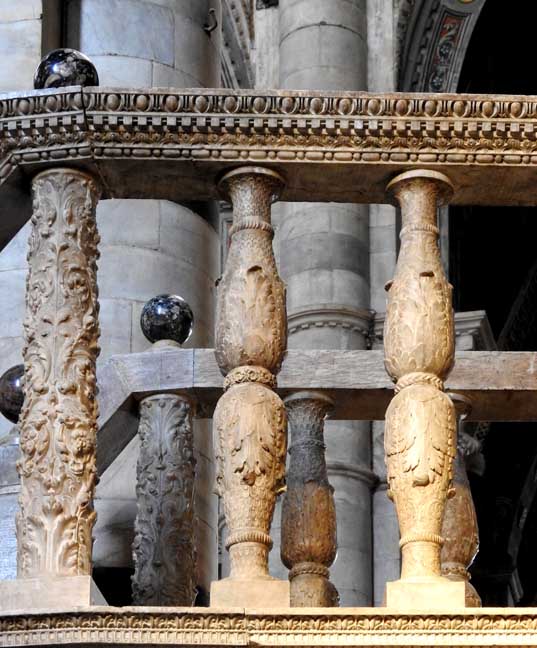 Pulpit - Detail #10 Terra cotta double-vase balusters ... Cf., similar balusters in Buffalo NY:  Stella Lowry row house, 497 Delaware Avenue, on the Midway, Buffalo, NY |
| Marble floor - Sibyls "Siena Cathedral contains
numerous masterpieces from every age, but its marble
mosaic inlay and graffito floor is in many ways its most prized
possession. Giorgio Vasari certainly considered it the 'most
beautiful..., largest and most magnificent floor ever made'. The floor
we see today is the product of a programme implemented between the 14th
and the 19th centuries.
"The technique used to transpose the various artists' ideas onto the floor is known as graffito and mosaic marble inlay. Simple to begin with, the technique gradually achieved an astonishing degree of perfection. The first inlays were traced out on white marble slabs using a chisel and a drill and then filled in with black stucco, a technique called 'graffito'. This was supplemented by a technique based on placing coloured marble pieces together using the marquetry method, a technique known as marble mosaic inlay." - Siena Opera Della Metropolitana: Cathedral Floor (online July 2021) Ten sibyls (five per side
aisle) - "Sibyl,
also called Sibylla,
prophetess in Greek legend and literature. Tradition represented her as
a woman of prodigious old age uttering predictions in ecstatic frenzy,
but she was always a figure of the mythical past, and her prophecies,
in Greek hexameters, were handed down in writing. In the 5th and early
4th centuries BC, she was always referred to in the singular; Sibylla
was treated as her proper name, and she was apparently located in Asia
Minor. From the late 4th century the number of sibyls was multiplied;
they were localized traditionally at all the famous oracle centres and
elsewhere, particularly in association with Apollo, and were
distinguished by individual names, 'sibyl' being treated as a title." -
Encyclopaedia Britannica (online March 2020)
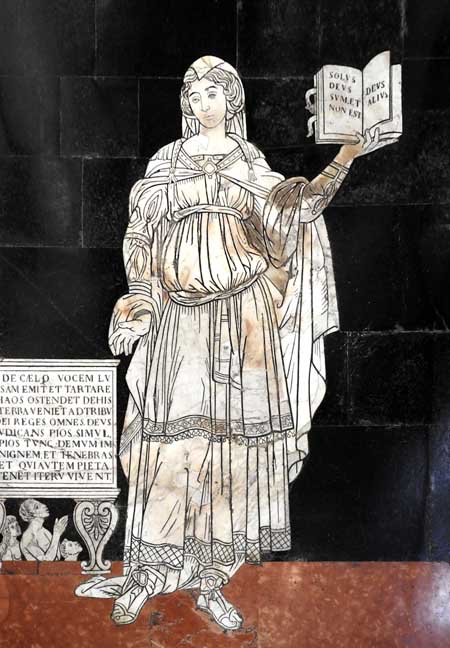 Phrygian Sibyl ... By Vito di Marco ... Another view below:  Phrygian Sibyl 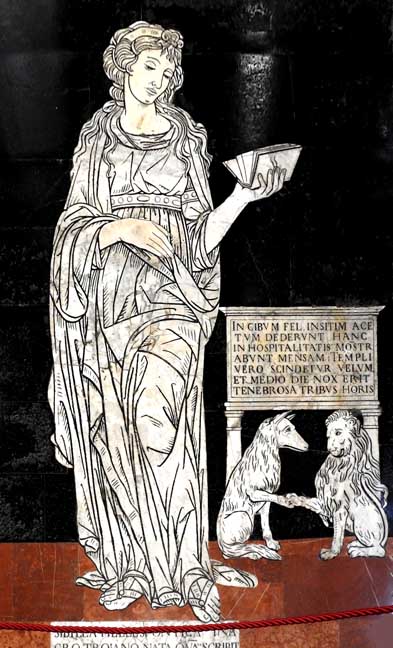 Hellespontine Sibyl ... By Neroccio di Bartolomeo ... Three details below:  Hellespontine Sibyl - Detail #1 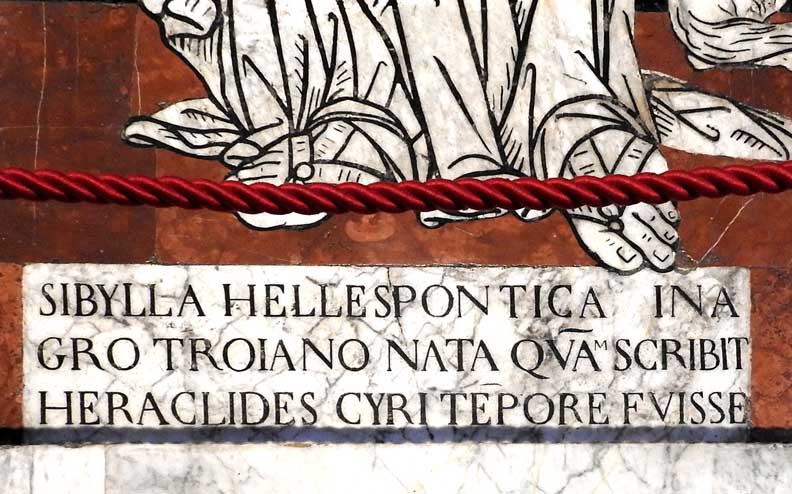 Hellespontine Sibyl - Detail #2 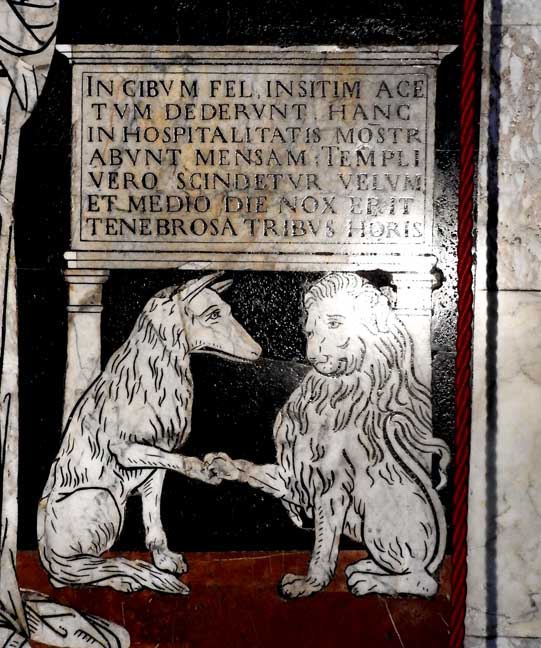 Hellespontine Sibyl - Detail #3 |
| Marble floor "Crafted by about forty artists
and artisans between the 14th and 16th centuries, the 56 panels
that constitute the floor vary in size and shape - most of them have a
rectangular shape, some a hexagon or a rhombus one - and are made
mainly by two different techniques: one known as graffito (tiny
holes
and cutting lines created in the marble and then filled with black
stucco and mineral pitch) and the one called 'marble intarsia' (black,
white, green, red and blue marble employed in much the same manner as
wood inlaying). The panels create an interlocking marble carpet
throughout the apse
and nave of
the cathedral – a masterpiece! –
drawing the figure of the Sibyls, scenes from the Old Testament,
allegories and virtues." - VisitTuscany.com
(online March 2020)
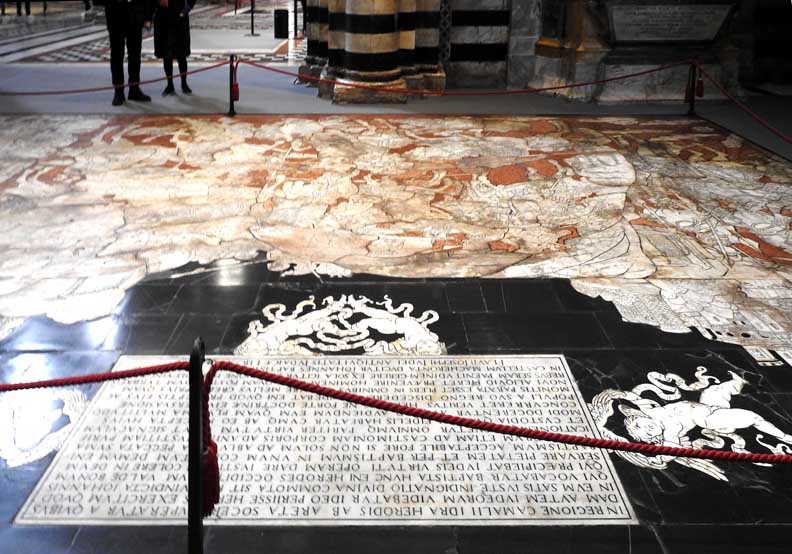 One of the 56 marble floor panels ... Eight details below: 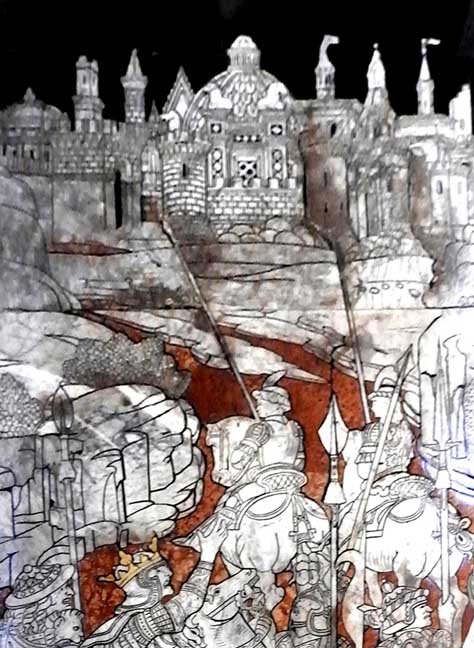  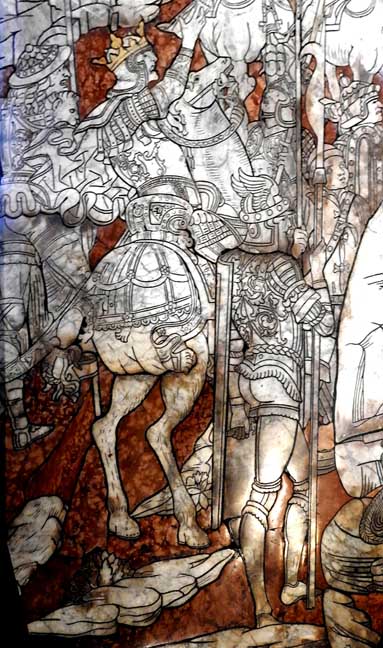 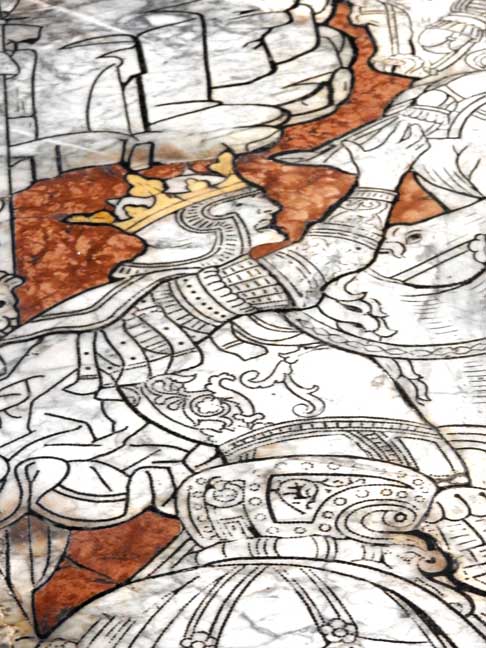 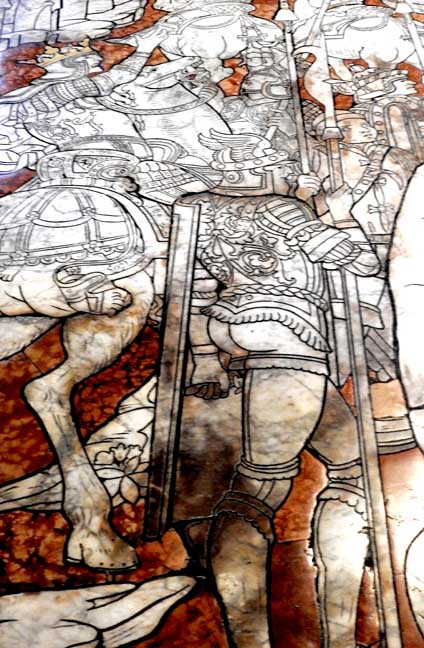 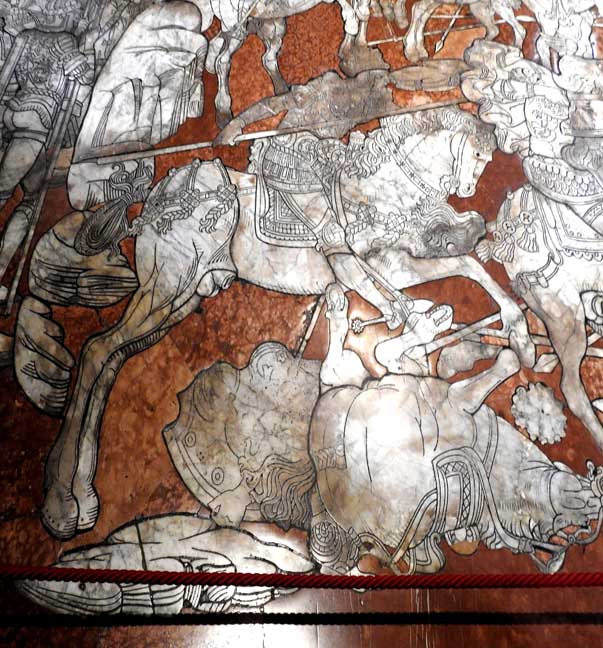 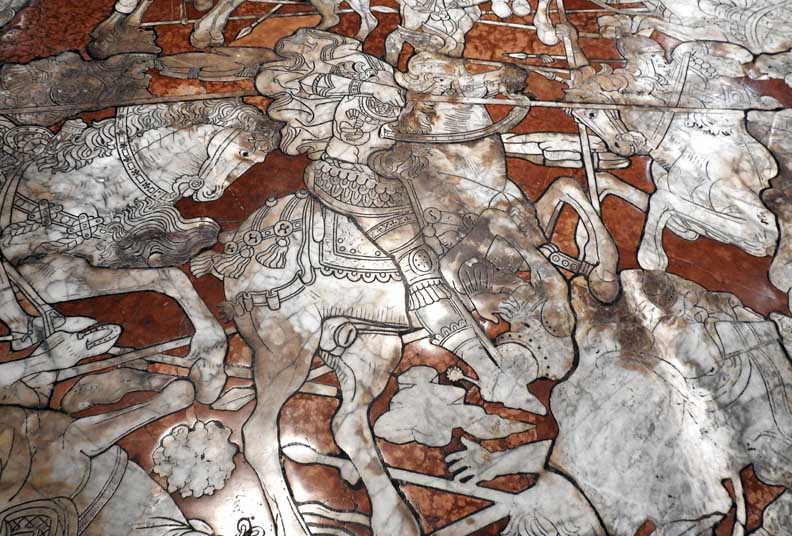  |
Transepts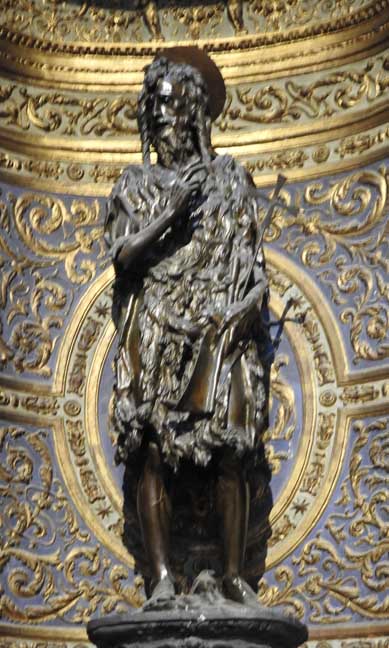 North transept Donatello's "St. John the Baptist" - companion piece to his Mary Magdalene in Florence South transept 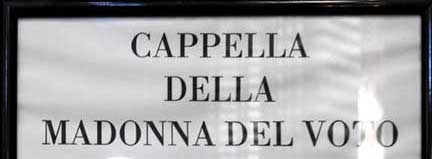 Chapel of the Madonna del Voto By Gian Lorenzo Bernini "The chapel of the Madonna
del Voto in Siena, whose entrance is at the beginning of the right
transept of the Cathedral, is the most important sanctuary dedicated to
Mary in the city. It holds the effigy of Our Lady of Graces Advocata
Senesium, the work of the painter Dietisalvi di Speme, known as
the “Madonna del Voto”. For centuries in fact, the people of Siena have
turned to her in moments of personal or collective difficulty, a fact
made clear through the many votive offerings hanging on the walls of
the chapel, donated to the Virgin by the faithful as a sign of
gratitude. According to tradition, in front of this painting the people
promised to devote themselves to Mary before the battle of Montaperti
(1260), in which the Sienese people triumphed over the superior
Florentine troops, bringing the city to its peak.
... In the second half of the 17th century, that space was demolished and the Sienese Pope Alessandro VII, born Fabio Chigi, decided to build the chapel that currently stands there, entrusting the works to the great Baroque artist Gian Lorenzo Bernini. The continuing desire to ensure a more noble context for the image of the Madonna is a tangible sign of the profound and constant devotion of the people of Siena towards the Virgin. Bernini designed a sumptuous space on a circular floor, characterised by a great abundance of marble. The crux of it is the altar: at the centre is the Madonna del Voto, supported by golden angels crafted from bronze who stand out on a background of blue lapis lazuli, the colour which represents divinity." - Visit Tuscany.com (online March 2020) 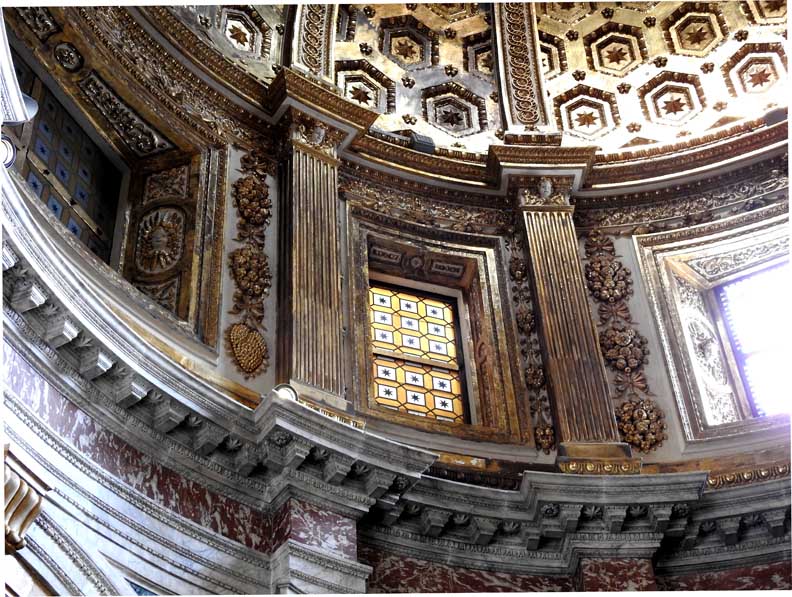 Chapel of the Madonna del Voto 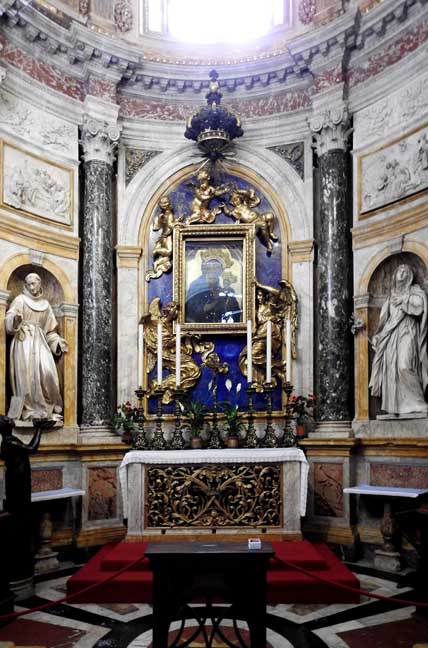 Chapel of the Madonna del Voto Baroque style 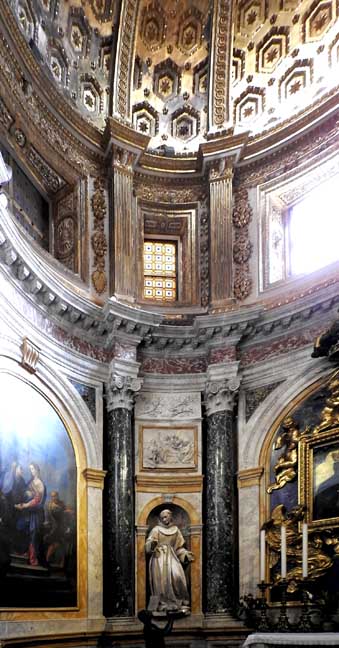 Chapel of the Madonna del Voto  Chapel of the Madonna del Voto 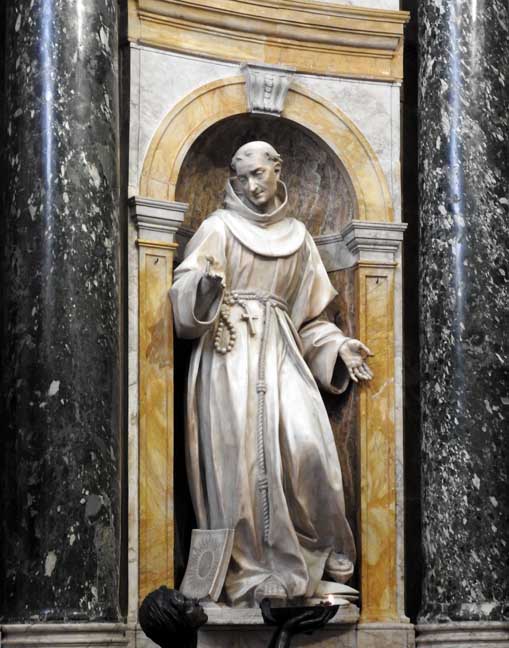 Chapel of the Madonna del Voto St. Dominic(?) with the rosary from Mary 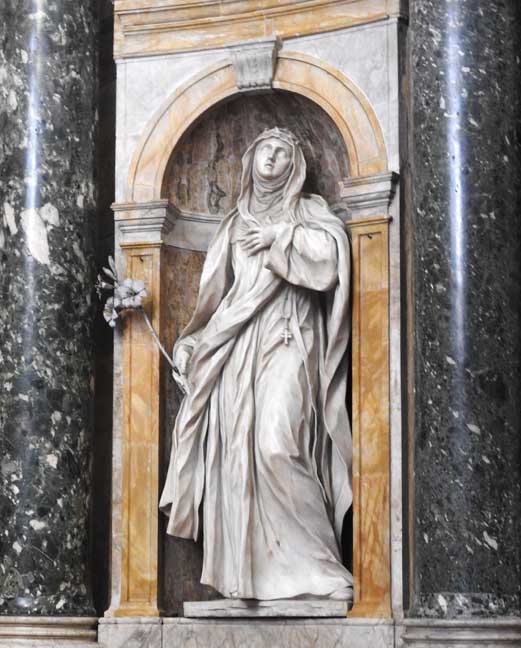 Chapel of the Madonna del Voto Mary with her symbolic lily 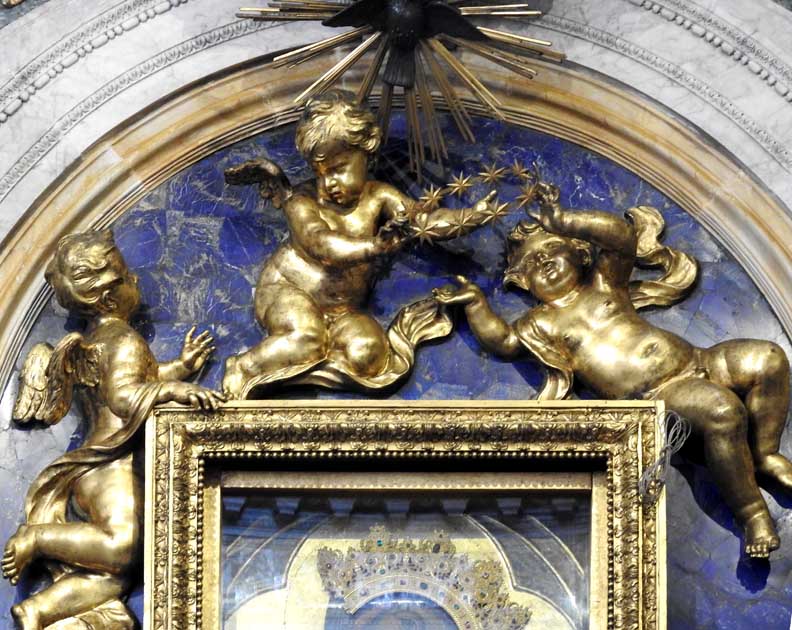 Chapel of the Madonna del Voto  Chapel of the Madonna del Voto "Madonna del Voto," by Dietisalvi di Speme  Chapel of the Madonna del Voto 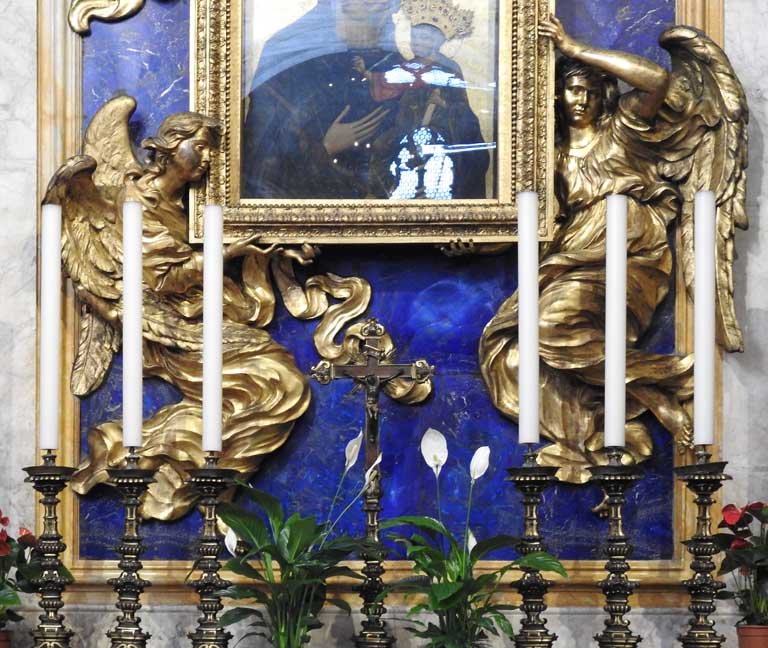 Chapel of the Madonna del Voto 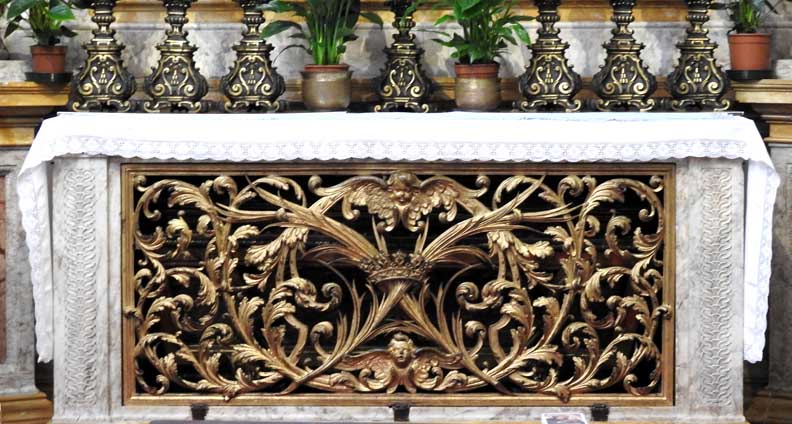 Chapel of the Madonna del Voto Angels ... Crown ... Scrolling acanthus leaves |
| Piccolomini
Altar "The
Piccolomini Altarpiece is an architectural and sculptural
altarpiece in the left-nave of Siena Cathedral, commissioned by cardinal
Francesco Todeschini Piccolomini who expected it to become his
tomb. However, he was elected Pope Pius III and buried in the Vatican.
"It was built between 1481 and 1485 by Andrea Bregno in Carrara marble, with additions in the following decades – these included four niche sculptures produced between 1501 and 1504 by Michelangelo of saints Peter, Augustine (later resculpted as Saint Pius), Paul and Gregory. On top of the altar is the Madonna and Child, a sculpture (probably) by Jacopo della Quercia. The central painting of the Madonna is by Paolo di Giovanni Fei and from the late 14th century. The altarpiece was restored in 2008." - Wikipedia (online March 2020) 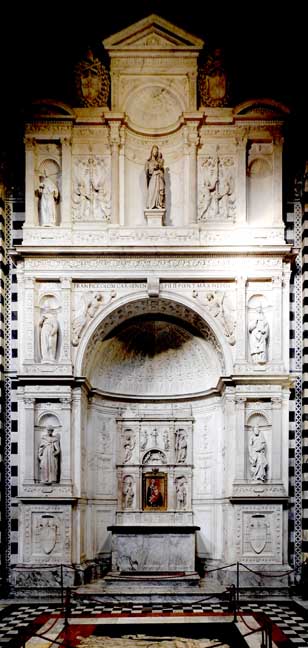 Piccolomini Altar, by Andrea Bregno ... Renaissance style ... 13 details below: 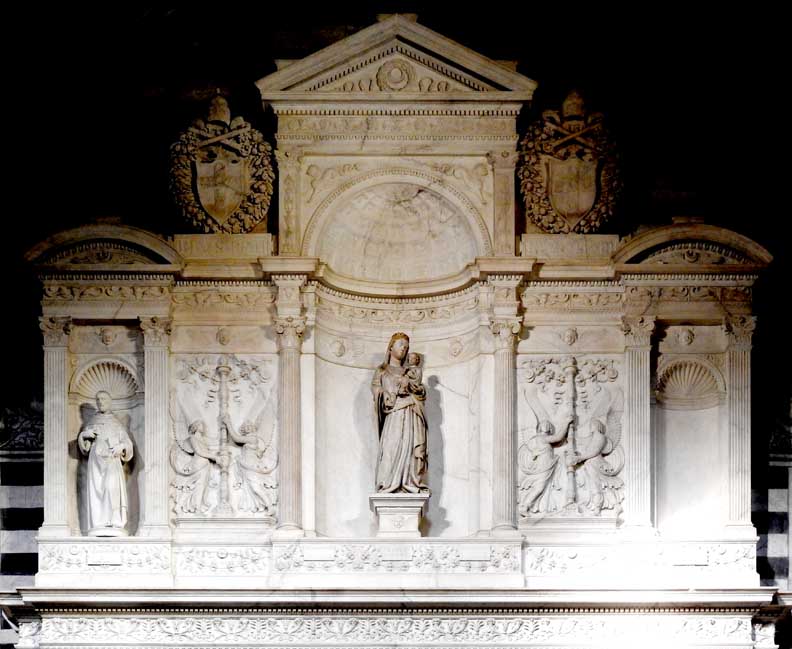 Piccolomini Altar - Detail #1 Carrara marble 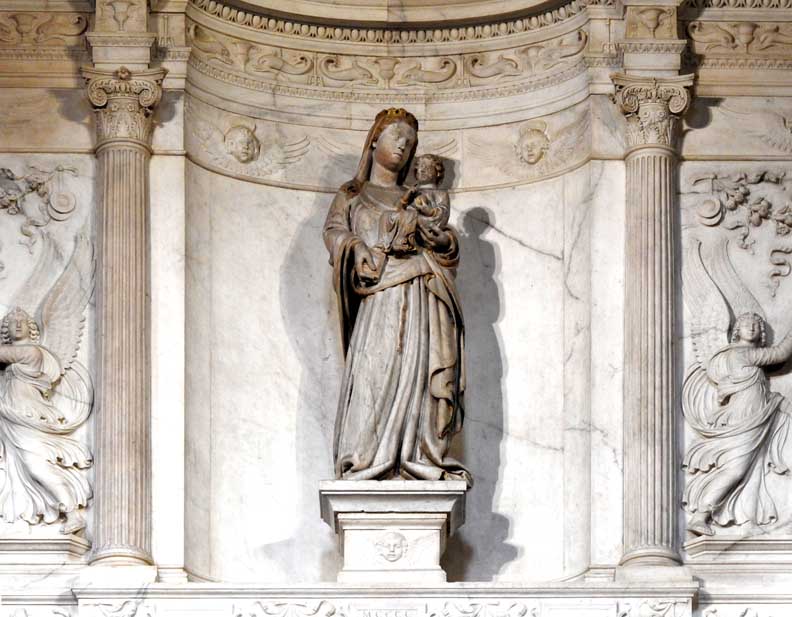 Piccolomini Altar - Detail #2 "Madonna and Child," (probably) by Jacopo della Quercia ... Ionic columns 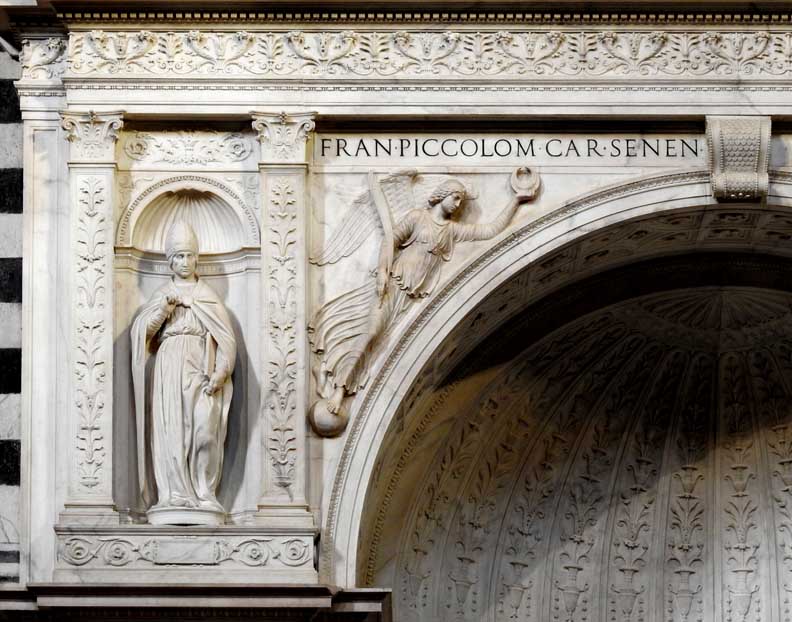 Piccolomini Altar - Detail #3 Angel in spandrel 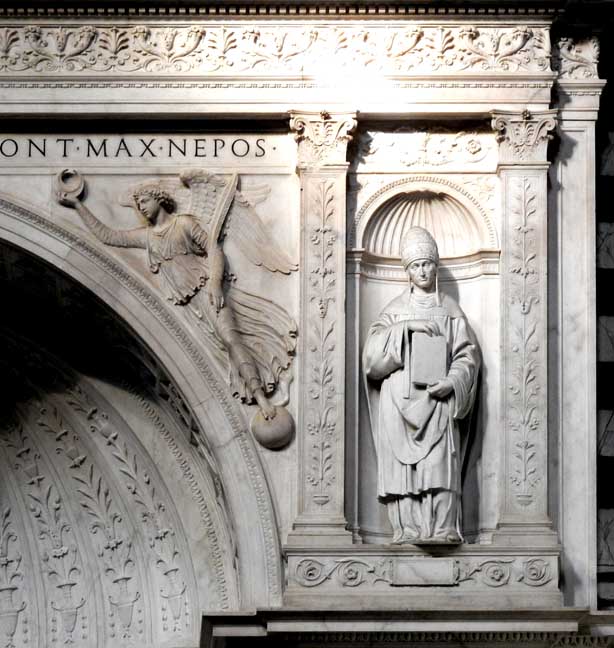 Piccolomini Altar - Detail #4 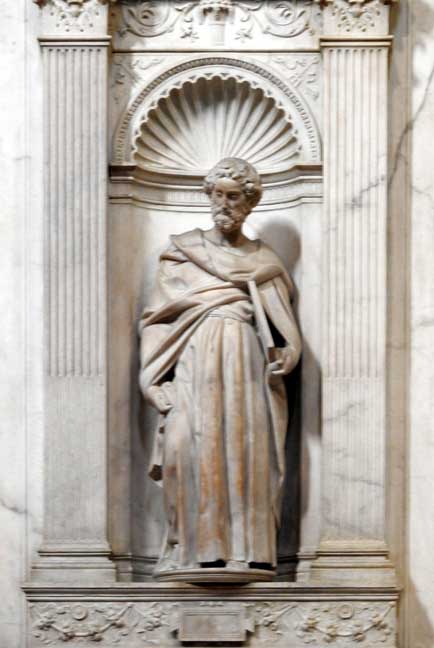 Piccolomini Altar - Detail #5 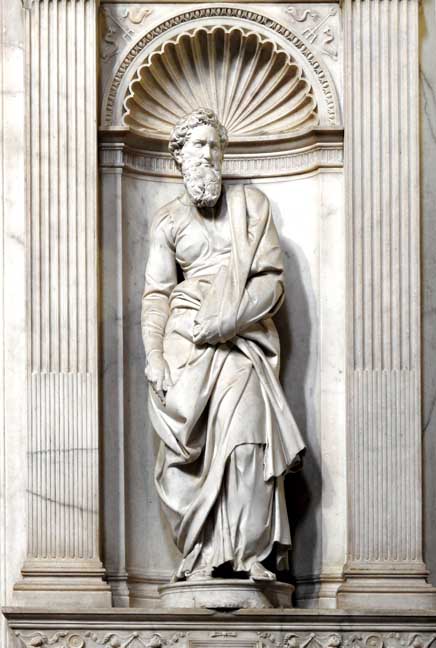 Piccolomini Altar - Detail #6 "Saint Paul," by Michelangelo Buonarroti ... Detail below: 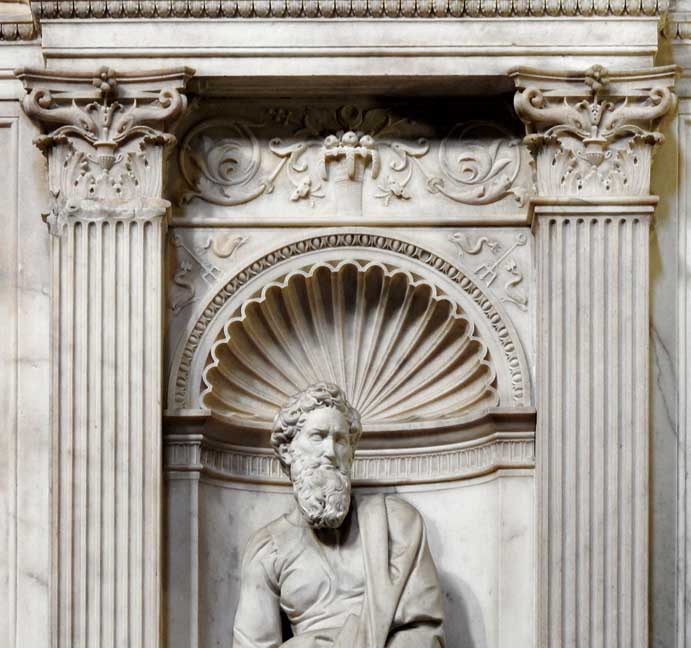 Piccolomini Altar - Detail #7 "Saint Paul" 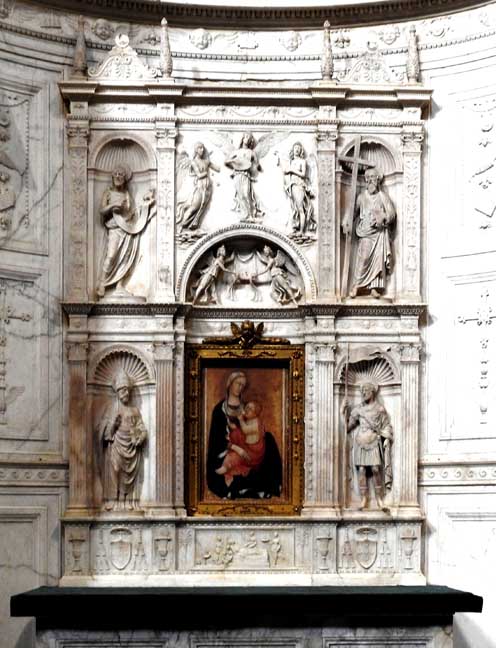 Piccolomini Altar - Detail #8 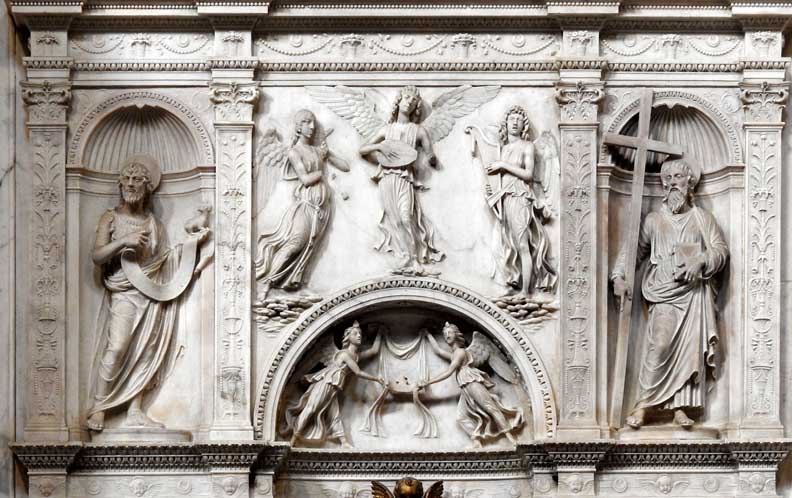 Piccolomini Altar - Detail #9  Piccolomini Altar - Detail #10 "Madonna Lactans"/"Nursing Madonna" 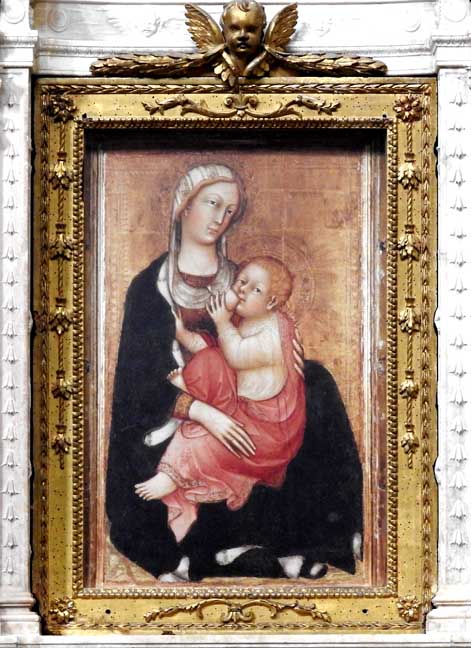 Piccolomini Altar - Detail #11 "Madonna Lactans"/"Nursing Madonna" By by Andrea Bregno Tempera on panel "This painting is placed in the
centre of the Carrara marble Piccolomini Altar by
Andrea Bregno in the left nave of Siena Cathedral. The Pope Pius
III, is an iconography of the Madonna and Child in which the
Virgin Mary is shown breastfeeding the infant Jesus.The depiction is
mentioned
by Pope Gregory the Great, and a mosaic depiction probably of the 12th
century is on the façade of Santa Maria in Trastevere in Rome, though
few other examples survive from before the late Middle Ages. It
continued to be found in Orthodox icons, especially in Russia." - Web Gallery
of Art (online March 2020)
 Piccolomini Altar - Detail #12  Piccolomini Altar - Detail #13 |
| Rear (main entrance) Opposite the main altar  Rear (main entrance) ... Eleven details below: 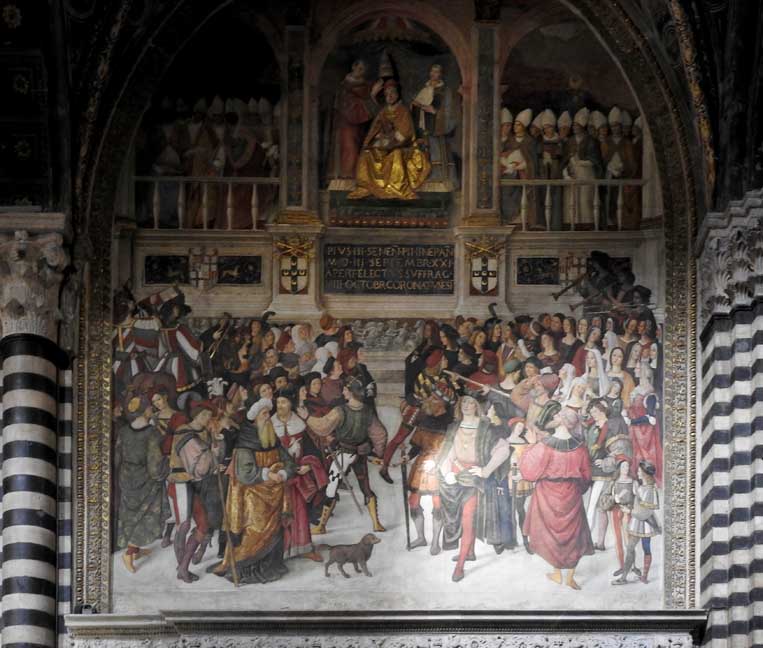 Rear - Detail #1 - "Crowning of Pope Pius III" "Pope Pius III (9 May
1439 – 18 October 1503), born Francesco Todeschini, was head of the
Catholic Church and ruler of the Papal States from 22 September 1503 to
his death. He had one of the shortest pontificates in papal history.
Francesco was the nephew of Pope Pius II, who granted him the use of the family name "Piccolomini", and appointed the twenty-one-year old Francesco as Archbishop of Siena. He served as papal legate in a number of places. In 1503, the frail, now Cardinal Piccolomini was elected pope as a compromise candidate between the Borgia and della Rovere factions." - Wikipedia (online March 2020) 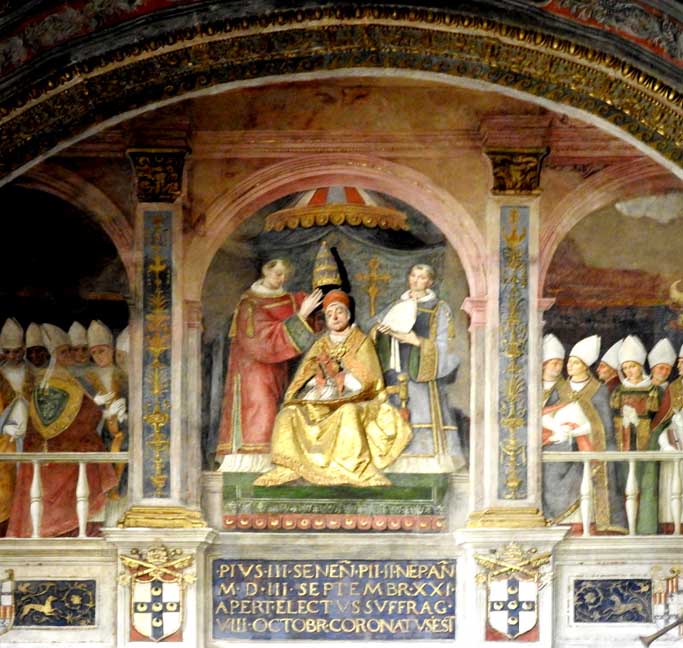 Rear - Detail #2 - "Crowning of Pope Pius III" A papal coronation was the ceremony of the placing of the papal tiara on a newly elected pope 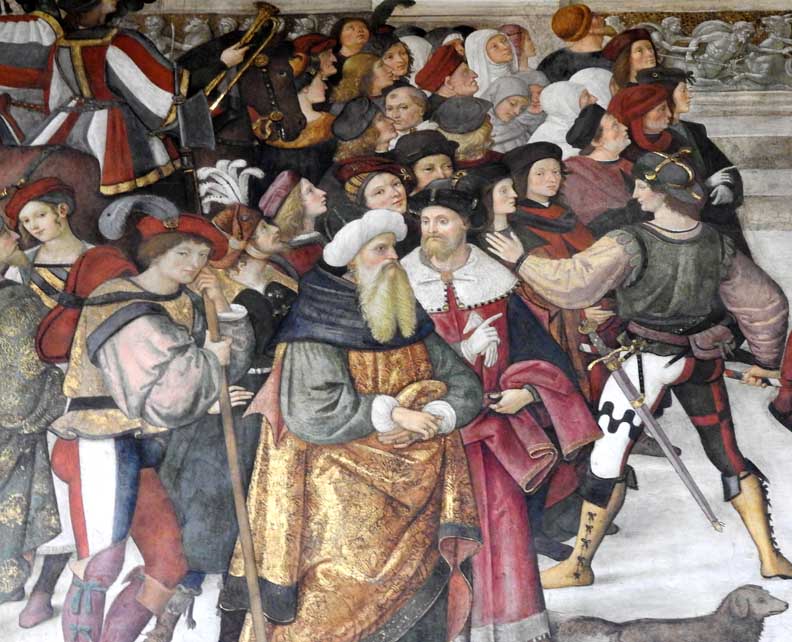 Rear - Detail #3 - "Crowning of Pope Pius III"  Rear - Detail #4 - "Crowning of Pope Pius III"  Rear - Detail #5 - "Crowning of Pope Pius III" 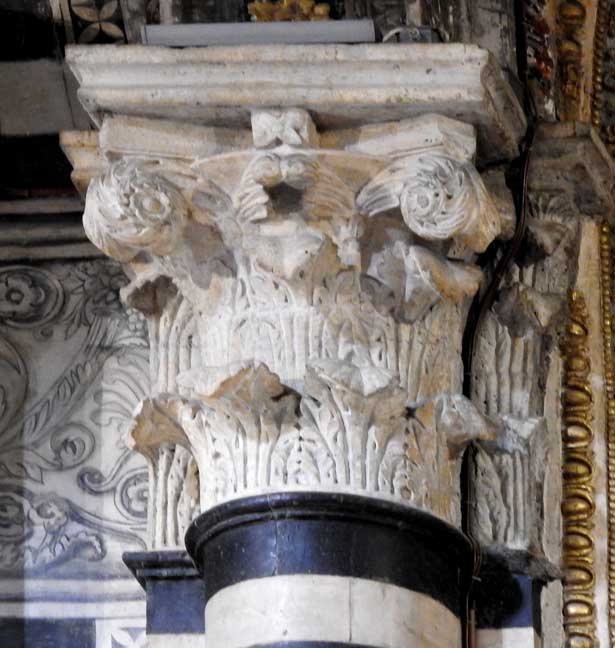 Rear - Detail #6 Corinthian capital 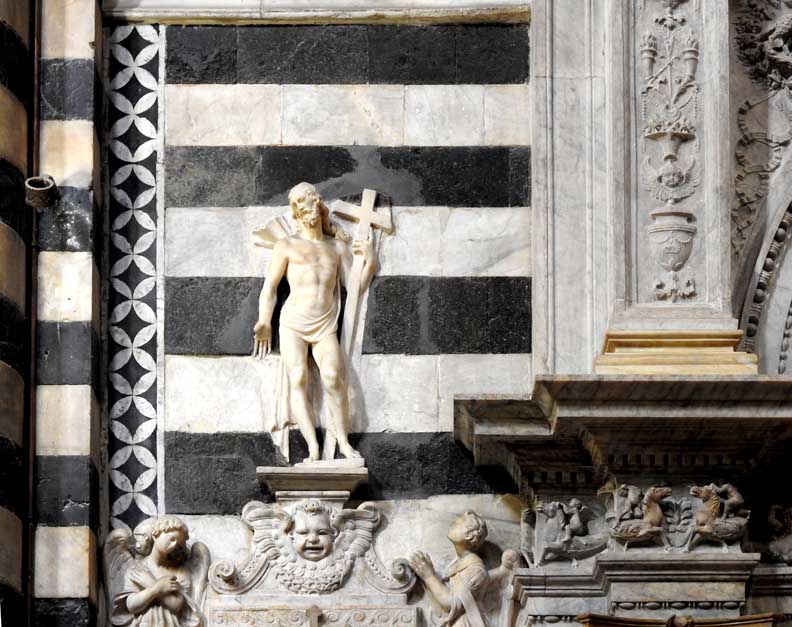 Rear - Detail #7  Rear - Detail #8 Bas-relief ... John the Evangelist with symbolic eagle  Rear - Detail #9 Marble, paneled Corinthian pilaster ... Two details below: 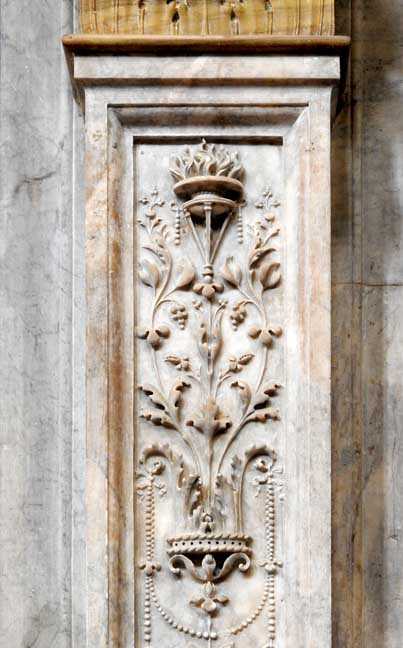 Rear - Detail #10 Flaming urn ... Scrolling acanthus leaves  Rear - Detail #11 |
|
Excerpts from Sacred Destinations: Sienna Duomo (online March 2020) The interior of Siena's Duomo is a rather dizzying sight, with its black-and-white striped pillars and ornate decoration on every surface. There is much to see throughout, including a number of important art masterpieces. Nave and clearstory The nave arcades, with rest on pillars with engaged columns of black and white marble, are very tall with round arches. There is no triforium. The walls of the clerestory have black-and-white stripes to match the pillars. Some of the nave capitals, which feature phytomorphic [foliated] sculptures, are thought to have been sculpted by Giovanni Pisano while he worked on the pulpit in the 1260s. The cornice that runs the length of the nave is decorated with busts of popes made in the workshop of Giovanni di Stefano beginning in 1495. Only four or five terracotta molds were used to make the busts, so many of them are identical. Below are 36 busts of Roman and Byzantine emperors from Constantine to Theodosius. Transepts The north transept is home to a bronze statue by Donatello of an emaciated St. John the Baptist, a companion piece to his Mary Magdalene in Florence. In the south transept is the Chigi Chapel, outside of which are paintings of St. Jerome and St. Mary Magdalene by Bernini. The Renaissance high altar is flanked by angels by Beccafumi. The celebrated pavement of Siena Cathedral features 59 etched and inlaid marble panels created from 1372 to 1547. The subjects include sibyls, scenes from Sienese history, and biblical scenes. The panels in the nave and aisles are usually on display (although roped off for protection) but the those in the transepts and apse are kept under protective cover, except from August 23 to October 3 during the Palio. Most of these are by Beccafumi. An important panel in the north transept is Matteo di Giovanni's Massacre of the Innocents (1481). The painter was worryingly preoccupied with this theme - his disturbing paintings can be seen in the Palazzo Pubblico and Santa Maria dei Servi. Pulpit A major highlight of the interior is the octagonal Gothic pulpit by Nicola Pisano (1265-68), assisted by his son Giovanni and others. It was created just a few years after Nicola's pulpit in the Pisa Baptistery (1260) and represents a further maturing of his artistic style. Four of the eight outer columns rest on lions, while the base of the central column is populated by the personified liberal arts. The seven marble panels depict the life of Christ in crowded scenes full of movement and life: |
